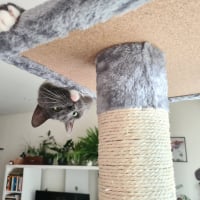🗳️ ELECTION 2024: THE MSE LEADERS' DEBATE Got a burning question you want us to ask the party leaders ahead of the general election? Submit your suggestions via this form or post them on our dedicated Forum board where you can see and upvote other users' questions. Please note that the Forum's rules on avoiding general political discussion still apply across all boards.
Discuss the 'Heat the human not the home' guide
Options
Energy costs are soaring, leaving many struggling to heat their homes. We wish we didn't need to be publishing this, but we've written a guide on how to Heat the human, not the home and would appreciate your feedback.
How did you find the info? Was it useful? Do you have any other tips you'd add?
Thanks for your help!
MSE Sarah
How did you find the info? Was it useful? Do you have any other tips you'd add?
Thanks for your help!
MSE Sarah
Follow MSE on other Social Media: MSE Facebook, MSE Twitter, MSE Deals Twitter, Instagram, Threads, Join the MSE ForumGet the Free MoneySavingExpert Money Tips E-mailReport inappropriate posts: click the report buttonFlag a news story: news@moneysavingexpert.com
1
Comments
-
Good morning,
I have long used a stone hot water bottle (often called a piggy).
It stays hotter much longer than a rubber hot water bottle, and in fact you should careful to wrap it in a towel as the outside can get very hot indeed. It has a stone stopper that screws in with a rubber ring underneath the stopper to prevent leaks.
I find that the water is still warm in the morning and I believe that, in Victorian times, people actually used the warm water to wash their face and make a (tepid) cup of tea, to avoid having to boil more water.
They are for sale on etsy and e-bay - though I appreciate that as they start at £8 (plus postage) that may be too much for some circumstances. There are still a lot around though so it may be worth seeing if you can find one more cheaply in a junk shop or charity shop.
Examples:https://www.etsy.com/uk/market/stoneware_hot_water_bottlehttps://www.ebay.co.uk/itm/234017153564
Kind regards,
Elljay6 -
You might have covered these elsewhere but posting anyway as a few additional suggestions. Have had years of practice, sadly.
Wear hats indoors. Up to 25% of your body heat is lost through your head. I personally find cotton beanies are best, but will wear woolly ones if the temp drop calls for it. You can pick up good quality woolly hats in charity shops for as little as £1.
Ditto scarves - if you don't like wearing rollnecks (like me) a cotton scarf will keep your neck and shoulders free of drafts. Again, can be picked up in charity shops for 50p - £1.00+. I got a lovely silk scarf for a quid a few years back: light, warm, non-sweaty and easy to wash in cold water.
Fingerless mitts are an essential staple in a cold house - I get through a couple of pairs a season. Charity shops or cheap shops - Home Bargains, B&M or my favourite, ProperJob - sell them for around £1.25 - £2.00.
I disagree with the synthetic base layer unless it's a polycotton blend (like most thermal base layers). Pure synthetics may be good for wicking away sweat when you're hiking up Ben Nevis, but if it's just for being indoors you're better off with cotton or cotton blends as they're much warmer on the skin. (Silk would be best - you can sometimes find these in charity shops.) I wear 3 T-shirts through the winter as a base layer: a vest, a long sleeve and a short sleeve, all bought in charity shops for a few quid each.
As well as the feet, keeping the back warm is essential - it helps with kidney function which can get sluggish if you cool down too much, making you feel even colder. Make sure your base layer at least is long enough to tuck into your lower garments and not ride up, and wear gilets or midriff body wraps - you can make the latter using bits of old blanket, towel, etc.
It seems completely counterintuitive, but - wash your hands in cold water, not hot. a) it saves heating the water up and b) cold water temporarily constricts local blood supply, reducing unnecessary heat loss. I suffered cold hands for years until I started doing this, and was amazed at the difference it made. If in doubt, just ask a window cleaner!
I also disagree with the slippers option, unless they're fake-Ugg quality and fully enclose the feet. You can pick up cheap thermal lined ankle boots from Ebay and similar (my last pair were £8.00 from Ebay), plus additional thermal insoles (2 pairs £1.00 from ProperJob) which will work much better. With thermal socks and the luxury of heated insoles too, you can have very toasty toes all day long!
Get thermostatic valves fitted EVERYWHERE. I only heat the rooms I use and then only to minimum tolerance levels. If you're wearing enough layers and keep moving eventually you won't notice the difference.
I hope these help.12 -
Not a good idea suggesting putting down rugs to help your feet stay warm, these can be a trip hazard for the elderly!!2
-
I don't think you're communicating well how layering works.Commercial base layer + 'mid layer' + waterproof layer only works for people being active, wearing specialist, technical clothing. Moisture wicking is important in those circumstances, because people are moving enough to generate enough sweat to be uncomfortable/to make their clothes wet.In other contexts and where people aren't wearing specialist clothing, the principle is that more thinner layers keep you warmer than a couple of thick layers because air is trapped between the layers. Three layers isn't enough. Three layers ought to be an autumn/spring baseline of vest + shirt/T shirt + jumper. For warmth in a cold home, aim for four to six layers, most of them T-shirt/top weight, at least some of them with long sleeves.4
-
I got a heated hoodie from the online home shop in winter and it's fantastic for layering as it is oversized, and really warm even without the heating function. It is also fairly cheap compared to the heated gilet in the original article, costing £25

3 -
When trecking in Tibet they had a system in the lodges called a "Tibetan Hot Table" (also see Japanese Heated Kotatsu Table) which could be modified for UK. In the evening the temperature dropped below zero. The large table with all the guests was surounded by benches with solid fronts. The table had old army blankets nailed to its sides. So sitting at the table with the blanket around your waist the space under the table was sealed. The lodge owner put a stove under the table. With a coat/jacket on the guests had their legs heated and we stayed warm even as the temperature dropped below zero. When the stove ran out of fuel that was the signal to run to your sleeping bags.Modifying this for the UK - with a coffee table in front of the couch/armchair and blankets over it all a small fan heater on low would keep you warm. For safety reasons the fan heater should be kept clear of any blanket perhaps weighted down in the center of the table or with clear air provided to the heater with tube made out of heavy cardboard box material.
1 -
I'm a chartered engineer specialising in the design of buildings, including heating. Your warnings about the advice are good but I think there needs to be more information as some essential information about the impact on health of cold homes is missing.
I'd recommend buying thermometers/temperature sensors so that people can check the air temperature in their rooms.
Public Health England recommend a minimum temperature of 18degC, both during the day and overnight, although healthy people can reduce the overnight temperature.
As you said, lower temperature can affect health due to damp but misses out other health and building affecting issues. Mould grows on surfaces that are below 14degC (which is possible even in a warm home) and can have a major impact on health and your house. Damp conditions are also good for growth of dust mites, rots and beetles.
I understand that the guide is for people in a desperate position but it shouldn't be used by those that can afford to heat their homes as the impact on their health and house could be disastrous.13 -
When shopping for food, think about the energy costs of cooking. Canned carrots, potatoes etc can be as cheap as buying them fresh and don't need as much energy to cook them. Ditto canned chicken, steak etc1
-
The most practical advice is wearing proper clothing indoors, my nephew wears shorts and T shirt indoors and has the thermostat at 24 degrees. The clothing doesn't need to be technical clothing, although my ancient merino base layer is warm I rarely need it as it's too warm in the UK.
I am now wearing a cotton T shirt and a fleece, plus cotton 3/4 leggings, no socks because I don't like them, although I do tend to sit with my feet under my bum.
We have feather cushions on the sofa seats, mostly because I find it more comfortable to sit on but they actually add a layer of insulation that makes sitting warmer.
Decades ago I worked street markets and we used to wear fur lined boot things with a plastic bag between 2 pairs of socks plus tights under jeans and layers on the top, that translated quite well to living in an old cottage.
We don't have fitted carpets, we have slate floors with one sitting room rug so I wear flipflops around the house to prevent my feet getting cold, cold feet do make the body feel cold.
The heating hasn't been on today and it's 19 degrees in here although it biting wind outside, it doesn't feel cold or hot.
We do have some throws from camping although they are mostly for the cat, I never use them but they are there should I need to.
Although I don't shower everyday, when I do it's just before bed because it warms you up getting into bed.
For those who need it an electric blanket is excellent, we don't have one now but did years ago in another house without heating, 10 minutes is enough.
We always have the bedroom window open at night, we don't want damp caused by condensation.
I'm sure about these other heated things, although hubby has handwarmers for when he's stargazing that he swears by.
We also eat lots of soups and similar, tonight chorizo and vegetable/potato stew spicy enough to warm you up and filling enough to not go to bed hungry.3 -
You can loose up to 25% of your body heat through your head. Wear a hat, is something I don’t see in the “Heat the human not the home” advice. A great aunt of mine always wore a knitted hat, similar to a beanie hat, indoors. She was born in 1898, so long before houses had heating anywhere except the front room (for special occasions) and the kitchen (in the range for cooking).
4
Categories
- All Categories
- 8 Election 2024: The MSE Leaders' Debate
- 343.8K Banking & Borrowing
- 250.3K Reduce Debt & Boost Income
- 450K Spending & Discounts
- 236K Work, Benefits & Business
- 609.1K Mortgages, Homes & Bills
- 173.4K Life & Family
- 248.6K Travel & Transport
- 1.5M Hobbies & Leisure
- 15.9K Discuss & Feedback
- 15.1K Coronavirus Support Boards



